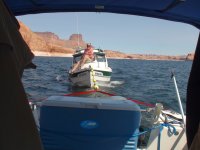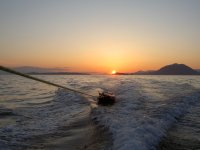Capital Sea
New member
Some time back I participated in a chat about towing a Walker Bay behind a 22' C-dory.
Now, I understand all of the limitations and own an inflatable with a 2hp Honda which went to Desolation Sound with us.
Thing is, we live on the protected waters of the South Puget Sound and when a friend put his 10' Walker Bay sailing dinghy up for sale, I jumped at the offer.
The boat has inflated cells from the bow and along the sides. I have a boat cover that can be very securely tied above the floats (between the floats and gunnel )
I have purchased floating tow line and seek help in design of the towing harness.
My intention is to tow this dinghy between State Parks, quiet bays or the yacht clubs island here in the south sound in nice weather in calm to moderate water conditions. The dinghy will be used to go ashore or will be rigged to sail around as we goof off for a day or two.
I am hip to the need to tow at the second wave or even third and the need to adjust for speed.
I assume I tie off at the two cleats at aft corners of the C-dory and intend to transition to one line which will run most of the way to the dinghy. I am told this single line should end at a stainless ring with a small float to compensate in terms of floatation. This design allows the "V" line from the back of the C-Dory to run through the ring at the end of the single line, so the dinghy can travel from side to side while distributing the load evenly.
So, is this the proper design?
Any advice would be much appreciated before I cut this costly line into two pieces.
Now, I understand all of the limitations and own an inflatable with a 2hp Honda which went to Desolation Sound with us.
Thing is, we live on the protected waters of the South Puget Sound and when a friend put his 10' Walker Bay sailing dinghy up for sale, I jumped at the offer.
The boat has inflated cells from the bow and along the sides. I have a boat cover that can be very securely tied above the floats (between the floats and gunnel )
I have purchased floating tow line and seek help in design of the towing harness.
My intention is to tow this dinghy between State Parks, quiet bays or the yacht clubs island here in the south sound in nice weather in calm to moderate water conditions. The dinghy will be used to go ashore or will be rigged to sail around as we goof off for a day or two.
I am hip to the need to tow at the second wave or even third and the need to adjust for speed.
I assume I tie off at the two cleats at aft corners of the C-dory and intend to transition to one line which will run most of the way to the dinghy. I am told this single line should end at a stainless ring with a small float to compensate in terms of floatation. This design allows the "V" line from the back of the C-Dory to run through the ring at the end of the single line, so the dinghy can travel from side to side while distributing the load evenly.
So, is this the proper design?
Any advice would be much appreciated before I cut this costly line into two pieces.


